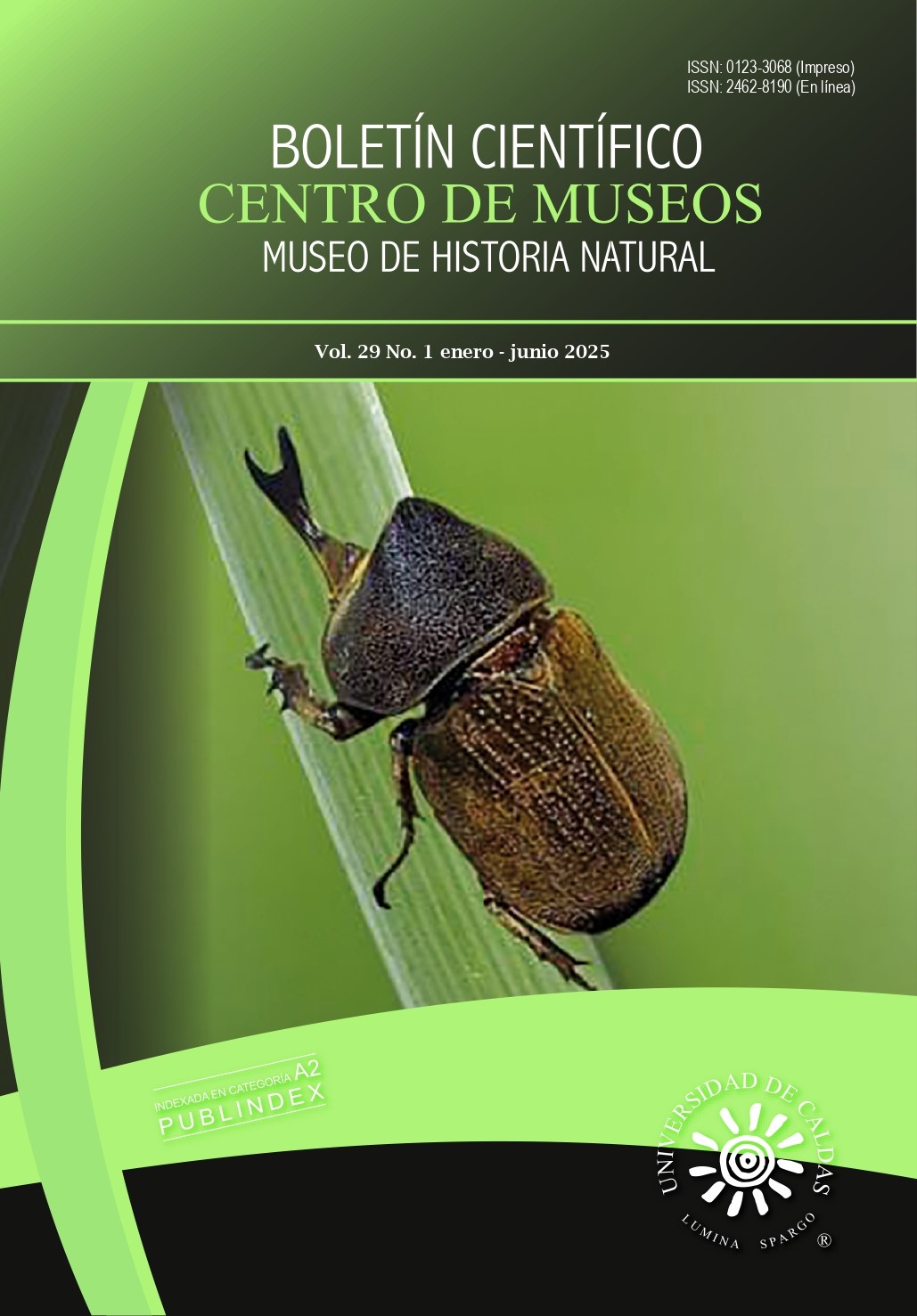Autores/as
Resumen
Colombia se destaca como uno de los países con mayor diversidad biológica del mundo; sin embargo, esta riqueza natural se encuentra amenazada debido a la transformación continua de sus ecosistemas, impulsada en gran medida por actividades antrópicas. Entre los biomas prioritarios para la conservación en el país se encuentran los ecosistemas de alta montaña, conocidos como páramos. Estos ambientes albergan altos niveles de endemismo y diversidad beta, además de cumplir un papel crítico en la captura, regulación y provisión del recurso hídrico. Los parámetros poblacionales derivados de análisis genéticos se han convertido en una herramienta fundamental para caracterizar la estructura, variabilidad y conectividad de las poblaciones naturales. Insectos como las mariposas se han utilizado como referencia del estado de un ecosistema, ya que sus parámetros poblacionales pueden extrapolarse al resto de la biota del lugar. Esta información resulta clave para identificar áreas prioritarias de conservación y diseñar estrategias efectivas de manejo. En este contexto, las mariposas diurnas emergen como valiosos bioindicadores: su respuesta frente a los cambios ambientales y su diversidad genética permiten realizar inferencias sobre la salud y resiliencia de los ecosistemas de páramo. Este artículo presenta perspectivas clave sobre la relevancia de la diversidad genética como insumo útil en la definición de estrategias de conservación en los páramos colombianos. A través del análisis genético de especies focales de mariposas, se busca fortalecer la toma de decisiones, priorizar poblaciones vulnerables, apoyar programas de suplementación, orientar esfuerzos de migración asistida y, en última instancia, contribuir a la formulación de políticas de conservación a largo plazo.
Palabras clave
Citas
Adams, M. J. & Bernard, G. I. (1997). Pronophiline butterflies (Satyridae) of the Sierra Nevada de Santa Marta, Colombia. Systematic Entomology, 2(4), 263-281. https://doi.org/10.1111/j.1365-3113.1977.tb00376.x
Ahola, V., Lehtonen, R., Somervuo, P., Salmela, L., Koskinen, P., Rastas, P., Välimäki, N., Paulin, L., Kvist, J., Wahlberg, N., Tanskanen, J., Hornett, E. A., Ferguson, L. C., Luo, S., Cao, Z., de Jong, M. A., Duplouy, A., Smolander, O.-P., Vogel, H., … Hanski, I. (2014). The glanville fritillary genome retains an ancient karyotype and reveals selective chromosomal fusions in lepidoptera. Nature Communications, 5(1), 4737. https://doi.org/10.1038/ncomms5737
Albright, E. A. & Crow, D. (2019). Beliefs about climate change in the aftermath of extreme flooding. Climatic Change, 155(1), 1-17. https://doi.org/10.1007/s10584-019-02461-2
Altamiranda-Saavedra, M., Naranjo-Díaz, N., Conn, J. E. & Correa, M. M. (2023). Entomological parameters and population structure at a microgeographic scale of the main Colombian malaria vectors Anopheles albimanus and Anopheles nuneztovari.PLOS ONE, 18(1), e0280066. https://doi.org/10.1371/journal.pone.0280066
Álvarez-Hincapié, C. F., Clavijo, A., Rojas, H., Uribe, S., Pyrcz, T. W. & Marín, M. A. (2017). Contribution of the influence area of the Páramo de Belmira (Santa Inés) to the regional diversity of Pronophilina (Lepidoptera: Satyrinae) of the northern Andes. Revista Mexicana de Biodiversidad, 88(2), 402-409. https://doi.org/10.1016/j.rmb.2017.03.007
Arellano, H. P. & Rangel, J. O. CH. (2008). Patterns in the distribution of vegetation in paramo areas: heterogeneity and spacial dependence. Caldasia, 30(2), 355-411.
Armenteras, D., Gast, F. & Villareal, H. (2003). Andean forest fragmentation and the representativeness of protected natural areas in the eastern Andes, Colombia. Biological Conservation, 113(2), 245-256. https://doi.org/10.1016/S0006-3207(02)00359-2
Avellaneda-Torres, L. M., Rojas, E. T. & Sicard, T. E. L. (2015). Alternatives to the conflict between environmental authorities and communities of protected areas in Colombian Páramos. Mundo Agrario, 16(31), 19-31.
Azrizal-Wahid, N., Rizman-Idid, M. & Sofian-Azirun, M. (2021). Phylogenetic relationships of Eurema butterflies from Peninsular Malaysia inferred from CO1 and 28S gene sequences with emphasis on Eurema hecabe. Raffles Bulletin of Zoology, 69, 262-271.
https://doi.org/10.26107/RBZ-2021-0021
Balvanera, P. (2012). Ecosystem services supplied by tropical forests. Ecosistemas, 21(1-2), 136-147.
Bell, E. V., Fencl, A. & Mullin, M. (2022). External drivers of participation in regional collaborative water planning. Policy Studies Journal, 50(4), 945-969. https://doi.org/10.1111/psj.12473
Benavides-Martínez, I. F., Burbano-Martínez, D. L., Urbano-Apráez, S. M. & Solarte-Cruz, M. E. (2007). The effect of the altitudinal gradient on autoecological features of Espeletia pycnophylla ssp. Angelensis cuatrec. (Asteraceae) in the paramo ‘El Infiernillo’ (Nariño–Colombia). Actual Biol, 29(86), 41-53.
Berteaux, D., Ricard, M., St-Laurent, M.-H., Casajus, N., Périé, C., Beauregard, F. & de Blois, S. (2018). Northern protected areas will become important refuges for biodiversity tracking suitable climates. Scientific Reports, 8(1). https://doi.org/10.1038/s41598-018-23050-w
Brown, B. V., Borkent, A., Adler, P. H., Amorim, D. S., Barber, K., Bickel, D., Boucher, S., Brooks, S. E., Burger, J., Burington, Z. L., Capellari, R. S., Costa, D. N. R., Cumming, J. M., Curler, G., Dick, C. W., Epler, J. H., Fisher, E., Gaimari, S. D., Gelhaus, J., … Zumbado, M. A. (2018). Comprehensive inventory of true flies (Diptera) at a tropical site. Communications Biology, 1(21), 1-21. https://doi.org/10.1038/s42003-018-0022-x
Cadena, C. D., Klicka, J. & Ricklefs, R. E. (2007). Evolutionary differentiation in the Neotropical montane region: molecular phylogenetics and phylogeography of Buarremon brush-finches (Aves, Emberizidae). Molecular Phylogenetics and Evolution, 44(3), 993-1016. https://doi.org/10.1016/j.ympev.2006.12.012
Cameron, S. L. (2014). Insect mitochondrial genomics: implications for evolution and phylogeny. Annual Review of Entomology, 59(1), 95-117. https://doi.org/10.1146/annurev-ento-011613-162007
Campbell, E. O., MacDonald, Z. G., Gage, E. V., Gage, R. V. & Sperling, F. A. H. (2022). Genomics and ecological modelling clarify species integrity in a confusing group of butterflies. Molecular Ecology, 31(8), 2400-2417. https://doi.org/10.1111/mec.16407
Casas-Pinilla, L. C., Mahecha-Jiménez, O., Dumar-Rodríguez, J. C. & Ríos-Málaver, I. C. (2017). Diversity of butterflies in a dry tropical forest landscape in la Mesa de los Santos, Santander, Colombia (Lepidoptera: Papilionoidea). SHILAP Revista de Lepidopterología, 45(177), 83-108.
Cepeda-Duque, J. C., Arango-Correa, E., Frimodt-Møller, C. & Lizcano, D. J. (2024). Howling shadows: First report of domestic dog attacks on globally threatened mountain tapirs in high Andean cloud forests of Colombia. Neotropical Biology and Conservation, 19(1), 25-33. https://doi.org/10.3897/neotropical.19.e117437
Chang, H., Liu, Q., Hao, D., Liu, Y., An, Y., Qian, L. & Yang, X. (2014). DNA barcodes and molecular diagnostics for distinguishing introduced Xyleborus (Coleoptera: Scolytinae) species in China. Mitochondrial DNA, 25(1), 63-69. https://doi.org/10.3109/19401736.2013.779260
Cognato, A. I. & Sperling, F. A. H. (2000). Phylogeny of Ips DeGeer Species (Coleoptera: Scolytidae) Inferred from Mitochondrial Cytochrome Oxidase I DNA Sequence. Molecular Phylogenetics and Evolution, 14(3), 445-460. https://doi.org/10.1006/mpev.1999.0705
Correa-Ayram, C. A., Etter, A., Díaz-Timoté, J., Rodríguez-Buriticá, S., Ramírez, W. & Corzo, G. (2020). Spatiotemporal evaluation of the human footprint in Colombia: Four decades of anthropic impact in highly biodiverse ecosystems. Ecological Indicators, 117, 106630. https://doi.org/10.1016/j.ecolind.2020.106630
Crone, E. E. & Schultz, C. B. (2022). Host plant limitation of butterflies in highly fragmented landscapes. Theoretical Ecology, 15(3), 165-175. https://doi.org/10.1007/s12080-021-00527-5
Dan, Z., Duan, L., Chen, Z., Guan, D. & Xu, S. (2021). Mitogenomes of three satyrid butterfly species (Nymphalidae: Lepidoptera) and reconstructed phylogeny of satyrinae. Diversity, 13(10), 1-18. https://doi.org/10.3390/d13100468
De Palma, A., Abrahamczyk, S., Aizen, M., Albrecht, M., Basset, Y., Bates, A., Blake, R., Boutin, C., Bugter, R., Connop, S., Cruz, L., Cunningham, S., Darvill, B., Diekötter, T., Dorn, S., Downing, N., Entling, M., Farwig, N., Felicioli, A., … Purvis, A. (2016). Predicting bee community responses to land-use changes: Effects of geographic and taxonomic biases. Scientific Reports, 6(1), 1-14. https://doi.org/10.1038/srep31153
D’Ercole, J., Dincă, V., Opler, P. A., Kondla, N., Schmidt, C., Phillips, J. D., Robbins, R., Burns, J. M., Miller, S. E., Grishin, N., Zakharov, E. V., DeWaard, J. R., Ratnasingham, S. & Hebert, P. D. N. (2021). A DNA barcode library for the butterflies of North America. PeerJ, 9, 1-22. https://doi.org/10.7717/peerj.11157
Dincă, V., Dapporto, L., Somervuo, P., Vodă, R., Cuvelier, S., Gascoigne-Pees, M., Huemer, P., Mutanen, M., Hebert, P. D. N. & Vila, R. (2021). High resolution DNA barcode library for European butterflies reveals continental patterns of mitochondrial genetic diversity. Communications Biology, 4(1), 1-11. https://doi.org/10.1038/s42003-021-01834-7
Dirnböck, T., Essl, F. & Rabitsch, W. (2011). Disproportional risk for habitat loss of high-altitude endemic species under climate change. Global Change Biology, 17(2), 990-996. https://doi.org/10.1111/j.1365-2486.2010.02266.x
Echeverría, S., Newbold, T., Hudson, L. N., Contu, S., Hill, S. L., Lysenko, I., Arbeláez, E., Armbrecht, I., Boekhout, T., Cabra, J., Dominguez, Y., Nates, G., Gutiérrez, D. L., Higuera, D., Isaacs, P. J., López, C. A., Martinez, E., Miranda, D., Navarro, L. E., … Purvis, A. (2016). Modelling and projecting the response of local assemblage composition to land use change across Colombia. Diversity and Distributions, 22(11), 1099-1111. https://doi.org/10.1111/ddi.12478
Fagua, G. (1996). Butterfly community and arthropods associated with three types of vegetation in the Serrania de Taraira (Vaupes, Colombia). A test on the use of butterflies as bioindicators. Revista Colombiana de Entomología, 22(3), 143-151.
Flantua, S. G. A., O’Dea, A., Onstein, R. E., Giraldo, C. & Hooghiemstra, H. (2019). The flickering connectivity system of the north Andean páramos. Journal of Biogeography, 46(8), 1808-1825. https://doi.org/10.1111/jbi.13607
Forero-Gómez, Y. K., Gil-Leguizamón, P. A. & Morales-Puentes, M. E. (2020). Structural connectivity between the Páramos of Guacheneque and Los Cristales, Rabanal-Río Bogotá complex, Colombia. Revista de Teledetección, 57, 65-77. https://doi.org/10.4995/raet.2020.13946
Frankham, R. (2015). Genetic rescue of small inbred populations: meta-analysis reveals large and consistent benefits of gene flow. Molecular Ecology, 24(11), 2610-2618. https://doi.org/10.1111/mec.13139
Freitas, B. M., Imperatriz-Fonseca, V. L., Medina, L. M., Kleinert, A. M. P., Galetto, L., Nates-Parra, G. & Quezada-Euán, J. J. G. (2009). Diversity, threats and conservation of native bees in the Neotropics. Apidologie, 40(3), 332-346. https://doi.org/10.1051/apido/2009012
Gil-Leguizamón, P. A., Morales-Puentes, M. E. & Carrillo-Fajardo, M. Y. (2021). Species richness of the vascular plants of the Bijagual high Andean forest, Colombia. Acta Botanica Mexicana, 128, 1-31.
Gil-Leguizamón, P. A., Morales-Puentes, M. E. & Jácome, J. (2020). Structure of the high Andean forest and paramo in the Bijagual Massif, Boyacá, Colombia. Revista de Biología Tropical, 68(3), 765-776. https://doi.org/10.15517/rbt.v68i3.34912
Gonzalez, S. J., García, M. R., Maldonado, J., Jimenez, L., Sánchez, A., Wilbert, T., Castro, S. L., Vargas, J. H., Quintanilla, S. R., Monsalve, H. & Escobar, C. J. (2017). Genetic Characterization of Jaguars (Panthera onca) in Captivity in Zoological Parks of Colombia. En Big Cats (Vol. 1). IntechOpen. https://doi.org/10.5772/intechopen.69779
González-Orozco, C. E. (2023). Unveiling evolutionary cradles and museums of flowering plants in a neotropical biodiversity hotspot. Royal Society Open Science, 10(10), 230917. https://doi.org/10.1098/rsos.230917
Gurrutxaga, M. S. V. & Lozano, P. V. (2006). Effects of habitat fragmentation and loss of ecological connectivity within territorial dynamics. Polígonos: Revista de geografía, 16(1), 35-54.
Hailay, G. & Getu, E. (2023). Diversity of butterflies across three land use types of Chebera Churchura National Park and its surroundings, Southwestern Ethiopia. Asian Journal of Conservation Biology, 12(1), 10-26. https://doi.org/10.53562/ajcb.73590
Henao-Díaz, F., Arrroyo, S., Cárdenas-Posada, G., Fernández, M., López, J., Martínez, D., Mendoza, J., Mondragón-Botero, A., León, O., Pulido-Herrera, K. L., Rodríguez-Cerón, N. & Madriñán, S. (2019). Biotic characterization of the forest-paramo transition zone in Chingaza Páramo Complex, Colombia. Biota Colombiana, 20(1), 132-145. https://doi.org/10.21068/C2019.V20N01A10
Jiménez, A. E. V. & González, A. V. V. (2017). Agroecological guidelines for the development of agro ecotourism in paramos. Turismo y Sociedad, 21, 253-273. https://doi.org/10.18601/01207555.n21.12
Kim, M. J., Chu, M., Park, J. S., Kim, S. S. & Kim, I. (2021). Complete mitochondrial genome of the summer heath fritillary butterfly, Mellicta ambigua (Lepidoptera: Nymphalidae). Mitochondrial DNA Part B, 6(5), 1603-1605. https://doi.org/10.1080/23802359.2021.1917318
Kim, M. J., Wang, A. R., Park, J. S. & Kim, I. (2014). Complete mitochondrial genomes of five skippers (Lepidoptera: Hesperiidae)
and phylogenetic reconstruction of Lepidoptera. Gene, 549(1), 97-112. https://doi.org/10.1016/j.gene.2014.07.052
Labadessa, R., Cagnetta, G., Desaphy, J. F., Bonifacino, M., Dodaro, G., Festa, D., Monterastelli, E., Papa, V., Zollo, L., Festa, E. & Dapporto, L. (2021). Using occurrence data to evaluate extinction reveals a strong resilience of butterflies in a National Park of Southern Europe (Alta Murgia National Park). Journal of Insect Biodiversity, 28(1), 1-12. https://doi.org/10.12976/jib/2021.28.1.1
Lanfear, R., Calcott, B., Ho, S. Y. W. & Guindon, S. (2012). Partitionfinder: combined selection of partitioning schemes and substitution models for phylogenetic analyses. Molecular Biology and Evolution, 29(6), 1695-1701. https://doi.org/10.1093/molbev/mss020
Lanfear, R., Frandsen, P. B., Wright, A. M., Senfeld, T. & Calcott, B. (2017). New methods for selecting partitioned models of evolution for molecular and morphological phylogenetic analyses. Molecular Biology and Evolution, 34(3), 772-773. https://doi.org/10.1093/molbev/msw260
Leinster, T. & Cobbold, C. A. (2012). Measuring diversity: the importance of species similarity. Ecology, 93(3), 477-489. https://doi.org/10.1890/10-2402.1
Lemes, R., Carvalho, A. P. S. & Ribeiro, T. C. (2015). Butterflies from urban green areas in Santa Maria, southern Brazil (Lepidoptera: Papilionoidea). SHILAP Revista de Lepidopterología, 43(169), 95-111.
Limeira, D. M., Santos, M. H., Mateus, R. P., Almeida, M. C. & Artoni, R. F. (2019). Genetic variability in a population of Astyanax scabripinnis: recent bottleneck and the possible influence of individuals with B chromosomes. Acta scientiarum. Biological sciences, 41(1), 1-11.
Liu, G., Chang, Z., Chen, L., He, J., Dong, Z., Yang, J., Lu, S., Zhao, R., Wan, W., Ma, G., Li, J., Zhang, R., Wang, W. & Li, X. (2020). Genome size variation in butterflies (Insecta, Lepidotera, Papilionoidea): a thorough phylogenetic comparison. Systematic Entomology, 45(3), 571-582. https://doi.org/10.1111/syen.12417
Mahecha-Jiménez, O., Dumar-Rodríguez, J. C. & Pyrcz, T. W. (2011). Effect of fragmentation of habitat on the community of Lepidoptera of the Pronophilini tribe along of an altitudinal gradient in an Andean forest in Bogota (Colombia) (Lepidoptera: Nymphalidae, Satyrinae). SHILAP Revista de Lepidopterología, 39(153), 117-126.
Mahecha-Jiménez, O., Triviño, P., Andrade, M. G. C. & Pyrcz, T. W. (2021). Two new species of Manerebia Staudinger from paramo habitat in the Colombian Eastern Cordillera of the Andes (Lepidoptera: Nymphalidae, Satyrinae, Pronophilina). Zootaxa, 4970(2), 293-302. https://doi.org/10.11646/zootaxa.4970.2.3
Mandeville, C. P., Nilsen, E. B., Herfindal, I. & Finstad, A. G. (2023). Participatory monitoring drives biodiversity knowledge in global protected areas. Communications Earth & Environment, 4(1), 1-10. https://doi.org/10.1038/s43247-023-00906-2
Marín, M. A., López, A., Freitas, A. V. L. & Uribe, S. I. (2009). Molecular characterization of Euptychiina (Lepidoptera: Satyrinae) from the northern Central Cordillera of the Andes. Revista Colombiana de Entomología, 35(2), 235-244. https://doi.org/10.25100/socolen.v35i2.9225
Martínez, M. A., Morillo, A. C. & Reyes-Ardila, W. (2020). Characterization of the genetic diversity in Passiflora spp. in the Boyacá Department, Colombia. Chilean journal of agricultural research, 80(3), 342-351. https://doi.org/10.4067/S0718-58392020000300342
Melo, D. H. A., Duarte, M., Mielke, O. H. H., Robbins, R. K. & Freitas, A. V. L. (2019). Butterflies (Lepidoptera: Papilionoidea) of an urban park in northeastern Brazil. Biota Neotropica, 19(1), 1-10. https://doi.org/10.1590/1676-0611-bn-2018-0614
Méndez-Polo, O. L. (2019). Emerging interests in high mountain areas and peasant life: tensions and contradictions of the delimitation of paramos in Colombia. Cuadernos de Geografía: Revista Colombiana de Geografía, 28(2), 322-339. https://doi.org/10.15446/rcdg.v28n2.70549
Möhlenhoff, P., Müller, L., Gorbushina, A. A. & Petersen, K. (2001). Molecular approach to the characterisation of fungal communities: methods for DNA extraction, PCR amplification and DGGE analysis of painted art objects. FEMS Microbiology Letters, 195(2), 169-173. https://doi.org/10.1111/j.1574-6968.2001.tb10516.x
Montejo-Kovacevich, G., Marsh, C. J., Smith, S. H., Peres, C. A. & Edwards, D. P. (2022). Riparian reserves protect butterfly communities in selectively logged tropical forest. Journal of Applied Ecology, 59(6), 1524-1535. https://doi.org/10.1111/1365-2664.14162
Muñoz-Pérez, J. M., Cañas, G. P., López, L. & Arias, T. (2022). Genome-wide diversity analysis to infer population structure and linkage disequilibrium among Colombian coconut germplasm. Scientific Reports, 12(1), 2958. https://doi.org/10.1038/s41598-022-07013-w
Muñoz-Valencia, V., Vélez-Martínez, G. A., Montoya-Lerma, J. & Díaz, F. (2021). Role of the Andean uplift as an asymmetrical barrier to gene flow in the neotropical leaf-cutting ant Atta cephalotes. Biotropica, 54, 191-204. https://doi.org/10.1111/btp.13050
Nates-Parra, G., Palacios, E. & Parra, A. H. (2008). Effect of landscape change on the structure of the sting-less bee community (Hymenoptera: Apidae) in Meta, Colombia. Revista de Biología Tropical, 56(3), 1295-1308. https://doi.org/10.15517/rbt.v56i3.5711
Newbold, T., Hudson, L. N., Hill, S. L. L., Contu, S., Lysenko, I., Senior, R. A., Börger, L., Bennett, D. J., Choimes, A., Collen, B., Day, J., De Palma, A., Díaz, S., Echeverria-Londoño, S., Edgar, M. J., Feldman, A., Garon, M., Harrison, M. L. K., Alhusseini, T., … Purvis, A. (2015). Global effects of land use on local terrestrial biodiversity. Nature, 520(7545), 45-50. https://doi.org/10.1038/nature14324
Noriega, J., Hortal, J., Azcárate, F., Berg, M. P., Bonada, N., Briones, M. J., Del Toro, I., Goulson, D., Ibanez, S., Landis, D. A., Moretti, M., Potts, S. G., Slade, E., Stout, J., Ulyshen, M., Wackers, F., Woodcock, B. A. & Santos, A. (2018). Research trends in ecosystem services provided by insects. Basic and Applied Ecology, 26(1), 8-23. https://doi.org/10.1016/j.baae.2017.09.006
Ocampo, J., Acosta-Barón, N. & Hernández-Fernández, J. (2017). Variability and genetic structure of yellow passion fruit (Passiflora edulis f. flavicarpa Degener) in Colombia using microsatellite DNA markers. Agronomía Colombiana, 35(2), 135-149. https://doi.org/10.15446/agron.colomb.v35n2.59973
Olaya-Angarita, J. A., Díaz-Pérez, C. N. & Morales-Puentes, M. E. (2019). Composition and structure of the forest-páramo transition in the Guantiva-La Rusia corridor (Colombia). Revista de Biología Tropical, 67(4), 755-768. https://doi.org/10.15517/rbt.v67i4.31965
Papasotiropoulos, V., Tsiamis, G., Papasotiropoulos, C., Loannidis, P., Klossa-Hilia, E., Papasotiropoulos, A., Bourtzis, K. & Kilias, G. (2013). A molecular phylogenetic study of aphids (Hemiptera: Aphididae) based on mitochondrial DNA sequence analysis. Journal of Biological Research-Thessaloniki, 20(1), 1-13.
Pardo-Pérez, E., Florez-Martínez, D. & Begambre-Hernández, M. (2024). Genetic analysis of the domestic pigeon (Columba livia) through feather colour-associated markers in Montería, Córdoba, Colombia. Veterinarska Stanica, 55(4), 397-407. https://doi.org/10.46419/vs.55.4.4
Parra-Romero, A. & Estupiñán, C. C. C. (2023). Do we inhabit the same mountain? Towards ontological openings in páramo conservation. Ambiente & Sociedade, 26, e01331. https://doi.org/10.1590/1809-4422asoc20210133r1vu2023L1OA
Peluso, L. M., Mateus, L., Penha, J., Súarez, Y. & Lemes, P. (2023). Climate change may reduce suitable habitat for freshwater fish in a tropical watershed. Climatic Change, 176(4), 44-55. https://doi.org/10.1007/s10584-023-03526-z
Pérez, J. H., Carneiro, E., Gaviria-Ortiz, F. G., Casagrande, M. M. & Mielke, O. H. H. (2019). Urban landscape influences the composition of butterflies in public parks and fragments in Southern Brazil. Community Ecology, 20(3), 291-300. https://doi.org/10.1556/168.2019.20.3.9
Pérez, J. H., Rocha-Gil, Z. E., Cifuentes-Osorio, G. R., Pérez-Rubiano, C. C. & Parrales-Ramírez, D. A. (2023). Physicochemical and biological structure as indicators of the environmental quality of surface water streams. Boletín Científico Centro de Museos Museo de Historia Natural, 27(1), 55-70. https://doi.org/10.17151/bccm.2023.27.1.3
Pérez, J. H., Rocha-Gil, Z. E., Pérez-Rubiano, C. C., Parrales-Ramírez, D. A. & Angulo-Flórez, D. H. (2024). Evolution of water quality in a water system in northern Boyacá using the BMWP/Col index. Boletin Cientifico del Centro de Museos, 28(1), 139-151. Scopus. https://doi.org/10.17151/bccm.2024.28.1.8
Pérez, J. H., Sánchez, R. E. & Salcedo, D. J. (2017). Diversity of butterflies present in the Police School Rafael Reyes of Santa Rosa of Viterbo, Boyacá, Colombia (Lepidoptera: Papilionoidea). SHILAP Revista de Lepidopterología, 45(178), 343-352.
Prado, S., Ngo, H. T., Florez, J. A. & Collazo, J. A. (2017). Sampling bees in tropical forests and agroecosystems: a review. Journal of Insect Conservation, 21(5-6), 753-770. https://doi.org/10.1007/s10841-017-0018-8
Pyrcz, T. W., Clavijo, A., Uribe, S., Marín, M. A., Álvarez, C. F. & Zubek, A. (2016). Páramo de Belmira as an important centre of endemism in the northern Colombian Andes: New evidence from Pronophilina butterflies (Lepidoptera: Nymphalidae, Satyrinae, Satyrini). Zootaxa, 4179(1), 77-102. https://doi.org/10.11646/zootaxa.4179.1.3
Pyrcz, T. W. & Garlacz, R. (2012). The Presence–Absence Situation and Its Impact on the Assemblage Structure and Interspecific Relations of Pronophilina Butterflies in the Venezuelan Andes (Lepidoptera: Nymphalidae). Neotropical Entomology, 41(3), 186-195. https://doi.org/10.1007/s13744-012-0031-2
Quiceno-Urbina, N. J., Tangarife-Marín, G. M. & Álvarez-León, R. (2016). Estimated biomass content, carbon sequestration and environmental services, in a forest area in the shelter primary indian Piapoco Chigüiro-Chátare, Barrancominas, Guainia Department (Colombia). Luna Azul, 43(1), 171-202. https://doi.org/10.17151/luaz.2016.43.9
Ramírez-Restrepo, L., Chacón-Ulloa, P. & Constantino, L. M. (2007). Diversity of diurnal butterflies (Lepidoptera: Papilionoidea and Hesperioidea) in Santiago de Cali, Valle del Cauca , Colombia. Revista Colombiana de Entomología, 33(1), 54-63.
Ramírez-Restrepo, L. & Halffter, G. (2013). Butterfly diversity in a regional urbanization mosaic in two Mexican cities. Landscape and Urban Planning, 115(1), 39-48. https://doi.org/10.1016/j.landurbplan.2013.03.005
Rangel-Acosta, J. L. & Martínez-Hernández, N. J. (2017). Comparison of copro-necrophagous beetle assemblages (Scarabaeidae: Scarabaeinae) among tropical dry forest fragments and the adjacent matrix in the Atlántico Department of Colombia. Revista Mexicana de Biodiversidad, 88(2), 389-401. https://doi.org/10.1016/j.rmb.2017.03.012
Ribeiro, D. B., Batista, R., Prado, P. I., Brown, K. S. & Freitas, A. V. L. (2012). The importance of small scales to the fruit-feeding butterfly assemblages in a fragmented landscape. Biodiversity and Conservation, 21(3), 811-827. https://doi.org/10.1007/s10531-011-0222-x
Rodríguez, D., Reyes, A., Gallegos-Sánchez, S., Reyes-Amaya, N., Gutierrez, J., Suárez, R. & Prieto, F. (2019). Northernmost distribution of the Andean bear (Tremarctos ornatus) in South America, and fragmentation of its associated Andean forest and Paramo ecosystems. THERYA, 10(2), 161-161.
Rushayati, S. B., Ginoga, L. N., Wijayanto, A. K., Zulhidayat, H. & Suryani, R. (2024). Environmental services potency of butterfly biodiversity as an ecotourism object in DKI Jakarta Province. IOP Conference Series: Earth and Environmental Science, 1366(1),012028. https://doi.org/10.1088/1755-1315/1366/1/012028
Saavedra-Ramírez, K. A., Etter, A. & Ramírez, A. (2018). Tropical ash (Fraxinus udhei) invading Andean forest remnants in Northern South America. Ecological Processes, 7(1), 16. https://doi.org/10.1186/s13717-018-0131-y
Sanín, M. J., Cardona, A., Céspedes Arias, L. N., González-Arango, C., Pardo, N. & Cadena, C. D. (2024). Volcanoes, evolving landscapes, and biodiversity in Neotropical mountains. Frontiers of Biogeography, 16(1), 1-14. https://doi.org/10.21425/F5FBG61882
Santos, J. P., Marini-filho, O. J., Freitas, A. & Uehara-Prado, M. (2016). Butterfly monitoring: the role of a biological indicator in the management of conservation units. Biodiversidade Brasileira, 6(1), 87-99.
Sarmiento, C., Osejo, A., Ungar, P. & Zapata, J. (2017). Inhabited moors: challenges for environmental governance of high mountains in Colombia. Biodiversidad en la Práctica, 2(1), 122-145.
Schaefer, H. & Renner, S. S. (2008). A phylogeny of the oil bee tribe Ctenoplectrini (Hymenoptera: Anthophila) based on mitochondrial and nuclear data: evidence for early Eocene divergence and repeated out-of-Africa dispersal. Molecular Phylogenetics and Evolution, 47(2), 799-811. https://doi.org/10.1016/j.ympev.2008.01.030
Sheffield, C. S., Hebert, P. D. N., Kevan, P. G. & Packer, L. (2009). DNA barcoding a regional bee (Hymenoptera: Apoidea) fauna and its potential for ecological studies. Molecular Ecology Resources, 9(1), 196-207. https://doi.org/10.1111/j.1755-0998.2009.02645.x
Shi, Q. H., Sun, X. Y., Wang, Y. L., Hao, J. S. & Yang, Q. (2015). Morphological characters are compatible with mitogenomic data in resolving the phylogeny of nymphalid butterflies (lepidoptera: papilionoidea: nymphalidae). PloS One, 10(4), 1-19. https://doi.org/10.1371/journal.pone.0124349
Smith, M. A., Bertrand, C., Crosby, K. & Eveleigh, E. S. (2012). Wolbachia and DNA barcoding insects: Patterns, potential, and problems. PLOS ONE, 7(5), 1-12. https://doi.org/10.1371/journal.pone.0036514
Smith, M. A., Fernandez-Triana, J., Roughley, R. & Hebert, D. N. (2009). DNA barcode accumulation curves for understudied taxa and areas. Molecular Ecology Resources, 9(1), 208-216. https://doi.org/10.1111/j.1755-0998.2009.02646.x
Sun, Y., Chen, C., Geng, X. & Li, J. (2021). Complete mitochondrial genome of Lasiommata deidamia and its phylogenetic implication to subfamily Satyrinae (Lepidoptera: Nymphalidae). Mitochondrial DNA Part B, 6(10), 2943-2945. https://doi.org/10.1080/23802359.2021.1955029
Tan, D., Parus, A., Dunbar, M., Espeland, M. & Willmott, K. R. (2021). Cytochrome c oxidase subunit I barcode species delineation methods imply critically underestimated diversity in ‘common’ Hermeuptychia butterflies (Lepidoptera: Nymphalidae: Satyrinae). Zoological Journal of the Linnean Society, 193(4), 1256-1270. https://doi.org/10.1093/zoolinnean/zlab007
Timmermans, M. J. T. N., Lees, D. C. & Simonsen, T. J. (2014). Towards a mitogenomic phylogeny of Lepidoptera. Molecular Phylogenetics and Evolution, 79(1), 169-178. https://doi.org/10.1016/j.ympev.2014.05.031
Traut, W., Sahara, K. & Ffrench-Constant, R. H. (2023). Lepidopteran Synteny Units reveal deep chromosomal conservation in butterflies and moths. G3 (Bethesda, Md.), 13(8), jkad134. https://doi.org/10.1093/g3journal/jkad134
Vasseur, L. & Andrade, A. (2024). Using the Red List of Ecosystems and the Nature-based Solutions Global Standard as an integrated process for climate change adaptation in the Andean high mountains. Philosophical Transactions of the Royal Society B: Biological Sciences, 379(1903), 1-8. https://doi.org/10.1098/rstb.2022.0326
Vergara-Buitrago, P. A., Morales-Puentes, M. E., Useche-Vega, D. S. & Gil-Leguizamón, P. A. (2018). Meetings for recognition and environmental learning with the farming community of the Rabanal moorland (Boyacá, Colombia). Revista geográfica venezolana, 59(2), 398-410.
Virgilio, M., Backeljau, T., Nevado, B. & De Meyer, M. (2010). Comparative performances of DNA barcoding across insect orders. BMC Bioinformatics, 11(1), 206-222. https://doi.org/10.1186/1471-2105-11-206
Wilson, I. G. (1997). Inhibition and facilitation of nucleic acid amplification. Applied and Environmental Microbiology, 63(10), 3741-3751.
Woodcock, B. A., Edwards, M., Redhead, J., Meek, W. R., Nuttall, P., Falk, S., Nowakowski, M. & Pywell, R. F. (2013). Crop flower visitation by honeybees, bumblebees and solitary bees: Behavioural differences and diversity responses to landscape. Agriculture, Ecosystems & Environment, 171(1), 1-8. https://doi.org/10.1016/j.agee.2013.03.005
Zhang, A. B., He, L. J., Crozier, R. H., Muster, C. & Zhu, C.-D. (2010). Estimating sample sizes for DNA barcoding. Molecular Phylogenetics and Evolution, 54(3), 1035-1039. https://doi.org/10.1016/j.ympev.2009.09.014

 PDF (English)
PDF (English)
 FLIP
FLIP
























